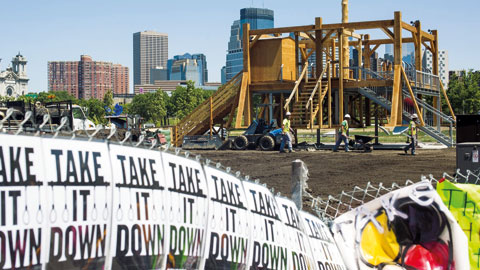What led to the dismantling of “Scaffold”?
We were scheduled to re-open the Sculpture Garden in June. The space is on Park Board land, which is also historically Dakota land – a private/public arrangement for this amazing space in the middle of Minneapolis. The garden held 60 sculptures – 18 of them were new. Meanwhile, we were running a museum with one of our biggest exhibitions ever, on Merce Cunningham. So we were very, very busy.
You could see the sculptures through the fencing. Sam Durant’s “Scaffold” was hard to miss. It had a prominent place at one of the Sculpture Garden entrances where school buses would soon park and kids would enter into the Sculpture Garden. It almost looked like a backyard playscape, but it was a gallows, and so, very ominous looking. Many of the staff were concerned about its scale and what it represented.
Our online managing editor – who writes content about the art world, about artists, about the Walker – did an interview with Sam. Before we published it, I found some language that I thought was problematic, so I sent it over to my sister at the Minnesota History Center. She’s done a lot of work with Native communities, specifically the Dakota. She immediately replied, “You don’t have a language problem, Annie. You have a sculpture problem.”
I quickly decided to take this looming issue to Olga Viso, the Executive Director. Soon after, we met with Native art world experts who said, “That sculpture has to come down or you will suffer irreparable consequences.” And that’s where it all started.
What did the artist intend with that work?
He wanted to open up these difficult histories around racial and criminal justice, to show that the US government had sanctioned these killings, allowed mass lynchings of people of color. He wanted it to be a learning space – but he now believes that he really miscalculated how it would be received.
No memorial has ever been built for this mass execution. So for Sam Durant, of California, to come and do it – on Dakota land – seemed to many to be inappropriate and insensitive. There are some sad and daunting statistics for the Native population here in Minnesota. And the staff were mortified that the Walker Art Center would add to what is already a tragic burden in their community. But that was the trajectory that emerged. From the Native perspective, it seemed like a prime example of how the white society does not understand or care about the Dakota people or their history.
One of the things Sam said was, “My work was created with the idea of creating a zone of discomfort for whites. Your protests have now created a zone of discomfort for me.” He would say it took on a new, deeper meaning that speaks a lot to his original purpose.
Did the protests surprise others at the center?
You can never predict what a crisis is going to be. That’s what makes it a crisis. We were all planning for other scenarios, like we wouldn’t be able to open the gates on time because construction would be behind or maybe somebody could climb on one of the sculptures and fall off and hurt themselves. We were never expecting anything like this.
Seeing the crisis emerging, what did you do?
We asked a Native curator and Native art educator to advise us, and they both categorically said, “It has to come down.” From the standpoint of any curator, that isn’t really a solution. The artist should be free to say what they want, no matter how difficult, and it’s our job to interpret. So, at their suggestion, Olga wrote a letter of apology for not engaging the Native community prior to electing and placing this piece, and sent it to The Circle, a small indigenous newspaper. We knew we were striking the match on a pile of very dry tinder to start the crisis – we did that because it was coming anyway.
What tactics did you use once it hit the media?
A year prior to the opening of the Sculpture Garden, I brought in a crisis management and communications guru. My concern was we wouldn’t know how to handle communications to all of our stakeholders (Board, community, Park Board, members, et cetera) in an orderly, thoughtful manner if a crisis happened.
For a full day, we were trained on communications preparation with the PR team, the Board and entire leadership staff at the Walker – how to recognize when something is going to be a crisis, and what to do once it hits. With hundreds of thousands of people coming into the Garden, something was going to go wrong. It was the best decision I ever made.
Once Olga’s letter was posted on The Circle’s digital news site, we gathered that same trained team and hunkered down for the entire Memorial Day weekend. We basically lived in this one room, with Olga Viso, the Board President, the Vice President and the leadership team, including Operations, Development, Web, Education and Curatorial. Our social media person was on hand at all times. We had to be extremely tight in our communications, internal and external. We had to make sure that press releases, our online publishing, our social media, our email and so forth, were all coordinated.

